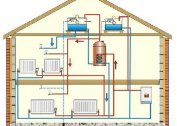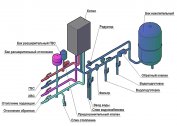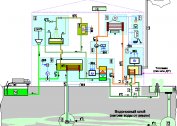One of the most important factors in building communication systems in a building is the maximum efficiency and the efficiency of their operation. This is especially true for heating systems.
The principle of operation of ceiling heating
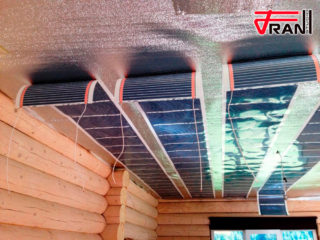 One of the most economical and energy-efficient methods of heating today is the ceiling. This innovative method is an infrared film with a reflector and resistors mounted in it. In other words, it is a two-layer aluminum foil, between the layers of which an electric voltage passes.
One of the most economical and energy-efficient methods of heating today is the ceiling. This innovative method is an infrared film with a reflector and resistors mounted in it. In other words, it is a two-layer aluminum foil, between the layers of which an electric voltage passes.
The principle of operation is that the electric current heats the resistors to a certain temperature (+35 -55 degrees), the resistors emit infrared waves 9-12 μm long, heating objects in the radius of the wave, which, in turn, give off secondary heat to the room : walls, furniture, home decoration, etc.
The nuances of installation and calculation
The power of a radiant heater manufactured by manufacturers ranges from 125 W to 150 W. In width, it can be from 30 to 120 cm, in length - from 1 to 7 m. The complexity of the installation of this device will depend on its size and characteristics of the ceiling.
Most often, heaters with a power of 150 watts are used. However, in each case, a calculation made by a specialist is required. The technical parameters of the room are very important here: size, ceiling height, characteristics of the finishing and heat-insulating material, etc.
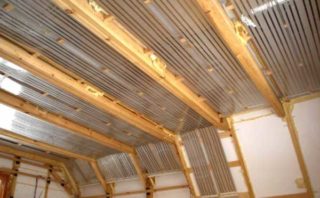 Install a film heater between the main ceiling coating and the insulating layer. In this case, the heating layer should not exceed 50% of the ceiling. As a rule, heaters are located along the walls. Firstly, this arrangement increases the heat transfer of wall ceilings, and secondly, there is enough space for the installation of lighting devices. The use of radiant heaters suggests the possibility of decorating the ceiling with any materials other than metal. An additional advantage for developers was the fact that the device of this system does not require any permits, which significantly saves the budget. In general, the installation of infrared heaters is simple and relatively inexpensive.
Install a film heater between the main ceiling coating and the insulating layer. In this case, the heating layer should not exceed 50% of the ceiling. As a rule, heaters are located along the walls. Firstly, this arrangement increases the heat transfer of wall ceilings, and secondly, there is enough space for the installation of lighting devices. The use of radiant heaters suggests the possibility of decorating the ceiling with any materials other than metal. An additional advantage for developers was the fact that the device of this system does not require any permits, which significantly saves the budget. In general, the installation of infrared heaters is simple and relatively inexpensive.
On average, the power consumption of the ceiling heater is about 55 watts per 1 meter of heated area. With a sufficient heat barrier at home, the cost of electricity will be approximately 6 kW per 100 square meters. m of living space. If we compare these indicators with heating by means of electric convectors, it is obvious that the cost of electricity is reduced by three or more times. No wonder manufacturers of infrared heaters position this method as the most energy-efficient.
The benefits of infrared heating
 This method is one of the most environmentally friendly and natural. It is no secret that the most comfortable warmth for all living things is solar heat. The infrared heating system works on the principle of returning the rays of the same spectrum as the solar ones. It does not burn oxygen, does not raise dust into the air. The effectiveness of this heating method is directly proportional to the thermal insulation characteristics of the room. If we refer to GOST, then the thermal protection of the building must comply with SNIP 23-02-2003, according to which the heat loss in the building should be minimized as much as possible.
This method is one of the most environmentally friendly and natural. It is no secret that the most comfortable warmth for all living things is solar heat. The infrared heating system works on the principle of returning the rays of the same spectrum as the solar ones. It does not burn oxygen, does not raise dust into the air. The effectiveness of this heating method is directly proportional to the thermal insulation characteristics of the room. If we refer to GOST, then the thermal protection of the building must comply with SNIP 23-02-2003, according to which the heat loss in the building should be minimized as much as possible.
Another advantage of this heating method is its safety. The low voltage inside the reflective foil eliminates the possibility of fire.The reliability of the heater is ensured due to the fact that the resistors are mounted in the film by separate modules: with mechanical damage to one, all the rest remain.
It is still difficult to talk about the maximum life of the heaters, since such devices have not yet been tried by time, but manufacturers guarantee the infrared heating system at least twenty-five years of operation and two years of warranty for identifying possible defects.
This heating system is undoubtedly suitable for any room, but it is especially good for use in wooden houses. The thing is that the tree during the precipitation period abundantly absorbs moisture, which leads to its deformation. At a minimum, the timber darkens, at the maximum it rots and becomes a good environment for the propagation of wood parasites and fungus. Ultimately, all this leads to the destruction of the entire building. A radiant heater in this case is the best protection against moisture and freezing. Due to the fact that from the ceiling, first of all, the walls are heated, as well as furniture and other objects, moderate heat is stably maintained in the room, which creates an optimal microclimate for wood.
The developers of the infrared heating system took care of the efficiency, safety and economy of the products - the most important criteria for these communications. Today, these systems are used in many countries of the world and receive a lot of positive feedback.
